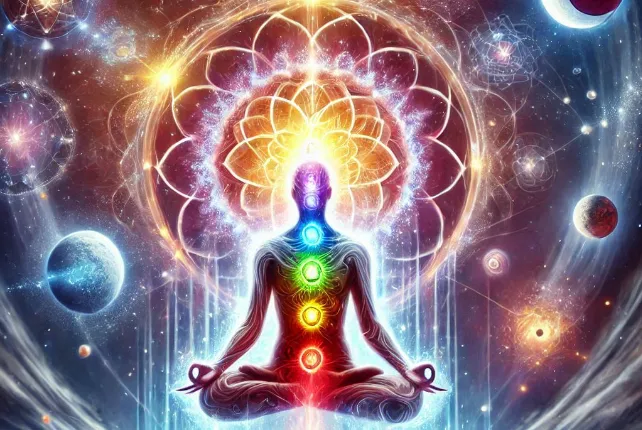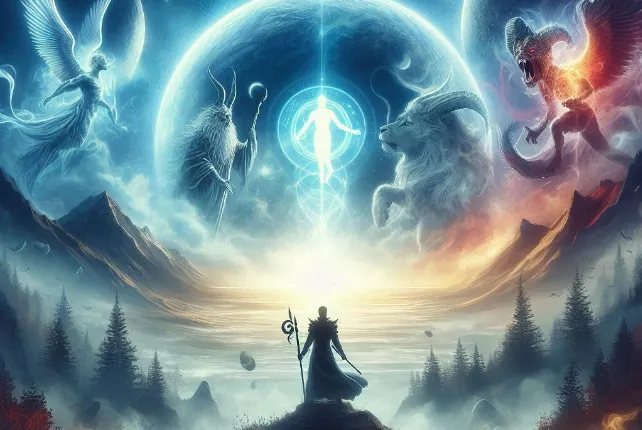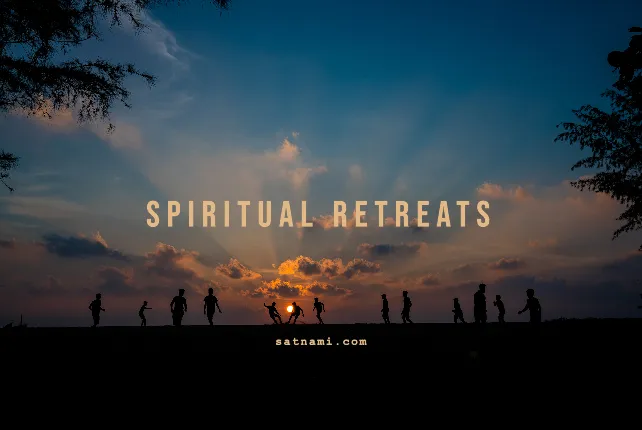The concept of Kundalini is ancient, originating in Eastern spiritual traditions, particularly within Hinduism and certain yogic practices. The term “Kundalini” literally translates to “coiled serpent,” referring to a dormant spiritual energy believed to reside at the base of the spine. When awakened, it has the potential to lead to profound transformation and enlightenment. This blog post will provide a step-by-step guide to understanding the Kundalini spirit, the awakening process, its benefits, challenges, and how to safely navigate this powerful spiritual experience.
1. What is the Kundalini Spirit?
The Kundalini spirit is the awakened energy that rises through the chakras, bringing a heightened state of awareness, enlightenment, and spiritual growth. It’s not an external being or deity, but rather a manifestation of energy that resides within each individual, waiting to be activated.
When the Kundalini energy rises, it ascends from the root chakra (at the base of the spine) to the crown chakra (at the top of the head). This energy flow is said to unlock higher consciousness and profound spiritual experiences. People who experience this awakening often report a deep sense of oneness with the universe and a greater understanding of their purpose in life.
2. What Happens During a Kundalini Awakening?
Kundalini awakening is a transformative process that can occur gradually or spontaneously. Here’s what typically happens during an awakening:
Stage 1: Initial Stirring
In the early phase of awakening, you may begin to notice subtle changes in your energy levels, thoughts, and emotions. This could manifest as:
- Increased vitality and enthusiasm.
- A sense of spiritual longing or searching for meaning in life.
- A desire to explore spiritual practices like meditation, yoga, or prayer.
Stage 2: Cleansing and Purification
As the Kundalini energy begins to rise through the chakras, the process can become intense. You may experience:
- Emotional purging: Old wounds, trauma, or unresolved emotions may surface.
- Psychological discomfort: You might feel overwhelmed or confused as the energy activates.
- Physical sensations: Tingling, heat, or vibrations may be felt in the body.
This stage is often uncomfortable but necessary, as the body and mind are being “cleansed” to make space for higher consciousness.
Stage 3: Rising Energy and Opening of the Chakras
As the energy moves upward, it opens each chakra, from the root to the crown. This may lead to:
- Increased awareness of your thoughts, actions, and surroundings.
- Intense periods of creative inspiration or intellectual insight.
- Enhanced connection to your intuition or a sense of inner knowing.
This stage can feel euphoric, as it brings profound shifts in perception and a deeper connection to the divine.
Stage 4: Enlightenment and Unification
At the final stage of awakening, the individual experiences a sense of spiritual enlightenment and unity. This may include:
- A deep sense of inner peace and tranquility.
- A feeling of oneness with the universe and all beings.
- Expanded consciousness and understanding of the interconnectedness of life.
This is the ultimate goal of the Kundalini awakening process—reaching a state of bliss and harmony with the cosmos.
3. How Does Kundalini Awakening Occur?
Kundalini awakening can happen in several ways, depending on the individual and their spiritual practices. Here are the most common methods:
a) Meditation and Prayer
Some people intentionally awaken their Kundalini energy through dedicated spiritual practices like meditation and prayer. Focusing on the breath and chanting mantras are two common ways to begin the awakening process. Through deep meditation, individuals can access higher states of consciousness, helping to gradually raise the Kundalini energy.
b) Yoga and Breathwork
Yoga, particularly Kundalini Yoga, is specifically designed to activate the Kundalini energy. Kundalini Yoga includes physical postures, controlled breathing techniques (pranayama), and chanting to help raise the dormant energy. This practice aims to awaken and balance the chakras, allowing the energy to move freely through the body.
c) Spontaneous Awakening
For some individuals, Kundalini awakening happens spontaneously. This can be triggered by a deep emotional or spiritual experience, such as a life-changing event, trauma, or intense meditation practice. The energy may suddenly rise without warning, bringing with it intense emotional and physical sensations.
d) Shaktipat (Transmission of Energy)
In some spiritual traditions, a guru or teacher can initiate Kundalini awakening by transmitting energy to the student. This is called Shaktipat and may occur through touch, gaze, or even spoken words. The transmission is believed to activate the energy in the student’s body, allowing it to rise and transform them spiritually.
4. What Are the Benefits of Kundalini Awakening?
When the Kundalini energy is successfully awakened, it can lead to numerous benefits, both spiritual and personal. Some of the most profound effects include:
a) Spiritual Growth
Kundalini awakening is often seen as the path to spiritual enlightenment. It deepens your understanding of your true nature and your connection to the universe. As you move through the awakening process, you will experience a heightened sense of purpose and alignment with your higher self.
b) Emotional Healing
As the Kundalini energy moves through the body, it helps release deep emotional blockages and unresolved trauma. This process can result in emotional healing, inner peace, and the ability to live in the present moment.
c) Increased Awareness and Clarity
With the awakening of the Kundalini, you may experience heightened awareness and mental clarity. You may begin to see life through a new lens, with a deeper understanding of yourself and others.
d) Creative Flow and Intuition
Kundalini awakening often leads to a surge in creativity and intuition. As the energy rises through the chakras, the individual becomes more in tune with their inner guidance, leading to clearer decision-making and creative inspiration.
5. Potential Challenges of Kundalini Awakening
While Kundalini awakening brings many benefits, the process can be intense and challenging. Here are some potential difficulties that may arise:
a) Overwhelm and Confusion
The sudden rush of energy can overwhelm the mind and body. Individuals may feel mentally scattered, emotionally unstable, or physically drained. This is part of the purging process as the body adjusts to the new energy.
b) Physical Discomfort
During the awakening, you may experience various physical symptoms, such as:
- Tingling sensations or heat in the body.
- Shaking or involuntary movements.
- Headaches or dizziness.
These symptoms are often temporary and part of the body’s adjustment to the rising energy.
c) Emotional Turmoil
The process of Kundalini awakening can stir up repressed emotions, causing emotional volatility. It’s important to address these emotions through self-care practices, therapy, or spiritual counseling.
d) Spiritual Crisis
In some cases, individuals may experience what is called the “dark night of the soul,” a period of intense doubt, confusion, or loss of purpose. This can feel like a spiritual crisis, but it is often a phase of deep transformation and growth.
6. How to Safely Navigate a Kundalini Awakening
To ensure that the Kundalini awakening process is smooth and safe, it’s important to take several precautions:
a) Start Slowly
If you’re looking to awaken your Kundalini energy, don’t rush the process. Start with gentle practices like yoga and meditation, and gradually increase the intensity. Rushing the awakening can lead to imbalance and discomfort.
b) Focus on Grounding
It’s essential to stay grounded during the awakening process. Practices like walking in nature, journaling, and breathing exercises can help you stay balanced and connected to the Earth’s energy.
c) Seek Guidance
Kundalini awakening can be overwhelming, so it’s crucial to have support. Find an experienced teacher, guru, or spiritual guide who can help you navigate the process and provide wisdom along the way.
d) Practice Self-Care
Ensure you’re taking care of your physical, emotional, and mental well-being. Eat nourishing foods, get plenty of rest, and make time for relaxation to balance the intense energy you may experience.
Conclusion: Embracing the Journey of Kundalini Awakening
The journey of Kundalini awakening is a profound and transformative process that can lead to enlightenment, healing, and spiritual growth. Whether you choose to awaken this energy intentionally or experience it spontaneously, it’s important to approach the process with patience, mindfulness, and a sense of reverence. By understanding the stages, benefits, and potential challenges, you can navigate the Kundalini journey with confidence and awareness.
Remember, each person’s experience with Kundalini is unique, and there is no “one-size-fits-all” approach. Trust your intuition, seek guidance, and allow the energy to unfold naturally.
Meta Description: Discover a step-by-step guide to understanding the Kundalini spirit, its awakening process, benefits, challenges, and how to safely navigate this transformative spiritual journey.




